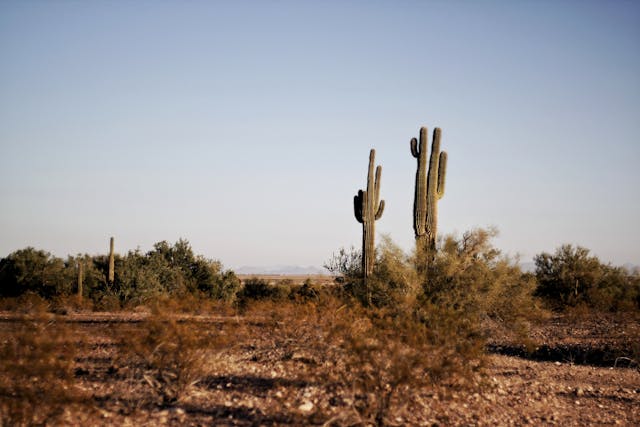Climate Change Impacts on Arizona’s Travel and Tourism
Arizona’s stunning landscapes — from the Grand Canyon to the red rocks of Sedona — draw millions of travelers each year. However, climate change is reshaping the way residents and tourists experience the state.
Extreme Heat
Arizona, particularly metropolitan areas like Phoenix, has seen record-breaking temperatures over the past decade. With more than 100 days per year topping 100°F (38°C), the extreme heat is pushing visitors to adjust travel dates, favor early-morning excursions, or seek indoor activities. Hiking trails frequently close midday during summer to protect public health, and outdoor festivals are increasingly scheduled for cooler months.
Wildfires and Air Quality
Arizona’s wildfire season has intensified due to rising temperatures and prolonged droughts. Fires like the Bush Fire and Telegraph Fire have not only endangered communities but also impacted major travel routes and destinations. Smoke from wildfires severely affects air quality, posing health risks for travelers, particularly those with respiratory conditions. Real-time air quality apps and wildfire trackers are becoming essential travel tools.
Water Scarcity
The persistent drought in the Southwest, fueled by climate change, is shrinking critical water sources such as Lake Mead and the Colorado River. Recreational activities like boating and river rafting face restrictions, and resorts, golf courses, and parks are under increasing pressure to implement water-saving measures. Travelers visiting Arizona now often encounter conservation notices and may find some water-based activities limited.
Corporate Initiatives and Innovations
In response to these mounting challenges, several Arizona-based corporations are leading the way with climate-smart initiatives.
Salt River Project (SRP): Driving Sustainable Infrastructure for Arizona’s Future
Salt River Project (SRP), another major Arizona utility provider, is deeply invested in sustainable infrastructure. SRP is increasing its renewable energy portfolio by expanding solar projects and water conservation initiatives — critical for supporting travel destinations reliant on Arizona’s natural beauty. Their “Sustainability by 2035” goals include reducing carbon emissions by 90% from 2005 levels, vital for maintaining livable conditions for visitors and locals alike.
Arizona Public Service (APS)
As the state’s largest electric utility, APS is central to Arizona’s clean energy transition. APS plans to deliver 100% clean, carbon-free electricity by 2050, with interim goals like achieving 65% clean energy by 2030. Solar energy is a major focus, particularly community solar programs that help support sustainable tourism infrastructure, such as eco-lodges, parks, and hospitality venues that rely on renewable power.
Local Travel Companies
Arizona-based tour operators are also innovating. Companies like Pink Adventure Tours (Sedona and the Grand Canyon) have begun transitioning fleets to low-emission vehicles. Boutique resorts and eco-lodges emphasize sustainable construction, water conservation systems, and native landscaping to reduce environmental impacts. Travel companies now routinely include educational components about climate change and conservation in their tours.
Adaptive Strategies for Travelers and the Industry
Both visitors and travel businesses must adapt to Arizona’s evolving climate reality.
Seasonal Travel Planning
The traditional high season of spring and fall remains ideal for Arizona travel, but the window is narrowing. Spring visits now favor earlier months like March and early April to avoid extreme heat. Fall offers great conditions from late October into early December. Travelers are advised to avoid midsummer unless they are prepared for the challenges of high desert temperatures.
Sustainable Travel Tips
Eco-conscious travel is no longer optional. Visitors should:
-
Book accommodations certified by eco-labels like LEED or Green Key.
-
Support local businesses that practice sustainability.
-
Choose group tours or low-emission transportation when possible.
-
Carry refillable water bottles to minimize plastic waste.
-
Stick to designated trails to help preserve fragile ecosystems.
Emergency Preparedness
Travelers should download apps like AirVisual for real-time air quality alerts and have flexible plans to accommodate wildfire-related closures. Hydration, sun protection (wide-brimmed hats, SPF 50+), and early morning activity scheduling are essential for summer travel. Awareness of evacuation routes and emergency contacts is critical when visiting wildfire-prone areas.
Future Outlook
Arizona’s future as a travel destination will increasingly depend on innovation, regulation, and community resilience.
Technological Innovations
Companies are exploring heat-resistant materials for building construction and outdoor infrastructure. Shade structures with built-in cooling mists, reflective roofing, and desert-adapted landscaping are becoming standard features in new travel facilities. Advancements in battery storage and solar cooling technology are helping businesses reduce their carbon footprints while maintaining visitor comfort.
Policy Developments
Arizona is adopting a growing number of environmental policies designed to support sustainable tourism. Cities like Tucson and Scottsdale have passed water conservation ordinances affecting hotels and resorts. The Arizona Office of Tourism has launched educational campaigns encouraging responsible recreation in fragile environments, such as the Sonoran Desert and protected river systems.
Community Engagement
Perhaps the most inspiring aspect of Arizona’s climate resilience is the role of local communities. Nonprofits like “Friends of the Verde River” promote river conservation through citizen science programs and eco-tourism. Indigenous communities share traditional ecological knowledge that helps travelers and researchers alike understand sustainable living in desert environments.
Visitors are increasingly being invited to participate — whether by joining reforestation projects, attending eco-festivals, or contributing to conservation efforts — helping foster a shared sense of stewardship for Arizona’s remarkable natural resources.
